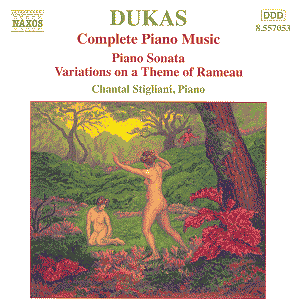The
young pianist, Chantal Stigliani, is a pupil of the renowned Yvonne
Lefébure. She shows a remarkable affinity for the music
of her homeland in this excellent release (the quality of both
playing and recording belie the super-budget price tag).
Dedicated
to Camille Saint-Saëns, the Piano Sonata is a remarkable
piece (Dukas was intensely self-critical, and would not let anything
less into the public domain that did not reach his high standards).
At over three quarters of an hour’s duration, it is a mini-marathon
for any player. Its language is of an almost Beethovenian concentration
at times.
The
shadow of César Franck seems to fall over some of the writing,
particularly in the organ-like left-hand passages. Stigliani has
a strong sense of rhythm which lends a certain inevitability to
proceedings: she only lets herself down with her broken octaves,
which can lack depth of sound and a sense of purpose. She is less
at home with the simplicity of the slow movement, and the shallow
recording does not help matters.
The
‘Vivement’ third movement may well help to explain the paucity
of performances of this piece. It is supremely difficult, and
unfortunately there is a touch of the typewriter to Stigliani’s
efforts. It is important to realise that there is also lyricism
in this music, but here the effect is more disjointed than anything
else. Things only improve towards the end of the movement, where
fragments are juxtaposed with chords.
The
Finale is an interesting piece, with hints of Ravel (around 6’06
is close to the climax of Jeux d’eau), not to mention a
Lisztian march.
Stigliani
comes into direct competition with Margaret Fingerhut on Chandos
(CHAN8765) at full price. Both performances are perfectly accepatble,
but whet we really need is a major player to take this piece under
his/her wing.
The
other major work is Variations, Interlude et Finale sur un
thème de Rameau. The theme is charming, with a distinct
French Drawing-room air about it. Right from the first variation,
though, Dukas recontextualises his material, making it his own
within a more perfumed setting. The’Interlude’ which separates
the eleventh variation from the Finale displays its Impressionist
credentials before a jaunty finale. Stigliani provides a convincing
interpretation of a little masterpiece.
Two
other pieces are included. In the title of La Plainte, au loin,
du faune, the reference to Debussy is obvious, and the piece
is indeed close in ethos to Prélude de l’après-midi.
It is played with great sensitivity here. Last, but not least,
the Prélude élégiaque’s Impressionist
canvas also holds clues as to Messiaen’s musical forefathers (especially
towards the end). Stigliani holds the rarefied atmosphere well.
Recommendable, then, especially given the price.
Colin
Clarke
